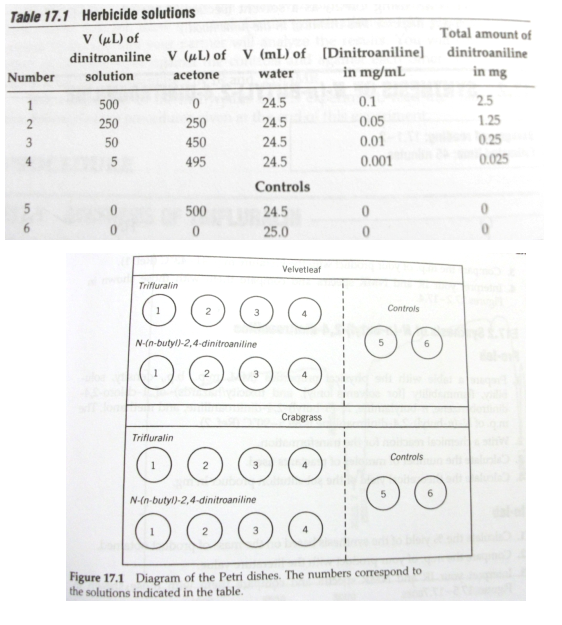Herbicide Effects of Trifluralin and N-(n-butyl)-2,4-Dinitroaniline
Herbicide Effects of Trifluralin and N-(n-butyl)-2,4-Dinitroaniline
Herbicide Solutions

Introduction
The purpose of this lab is to test the potency of trifluralin and N-(n-butyl)-2,4-Dinitroaniline as herbicides and the resistance of velvetleaf and crabgrass against them. This procedure consists of soaking crabgrass and velvetleaf seeds in various concentrations of the herbicide solutions and analyzing results after at least five days have passed.
Dinitroaniline herbicides were first discovered in 1964. They function by inhibiting cell division in the root cells of susceptible weeds, specifically by obstructing the process of synthesizing microtubules. The limited growth of the root and its resulting reduced function translates to dehydration for the plant, which is unable to uptake sufficient amounts of water, and eventual death. Resistance to trifluralin has been discovered in some plants and is accomplished by hyperstabilization of microtubules, which allows resistant weed root cells to successfully divide and prevent plant dehydration.
Safety hazards that should be taken into consideration include the irritant and possible mutagenic nature of Trifluralin as well as the toxicity of dinitroanilines in general. Skin contact should be avoided and gloves worn.
Experimental Sections
- Put 25mg of each dinitroaniline in separate 5-mL flasks with 5.0mL acetone
- Carry out dilutions indicated in Table 17.1, solutions 1-4, using 25-mL volumetric flasks and automatic pipets
- Assign and label 20 Petri dishes according to Figure 17.1
- Cut circles of paper towels to fit Petri dishes (9-cm diameter) with about 12 circles per dish
- Place six circles in each of the 20 bottom parts of the Petri dishes
- To ten of them, add 200mg of crabgrass seeds and 200mg of scarred velvetleaf seeds to the other ten
- Cover seeds with six circles of paper towel
- Water each dish with about 12mL of their respective solutions
- Circles should be wet but not drip water
- Cover dishes with other half
- Stack dishes and leave in well lit and warm place – not in direct sunlight
- After five days, remove circles covering seeds
- Observe germination and growth
- Determine which dinitroaniline is more potent and which weed is more resistant
Data and Observations
- Weed 1 flowers: blackening / browning of yellow flowers and stem
- Weed 2 flowers: blackening of entire flowers, bulbs, stems with a little bit of yellow remaining
- Control flowers not much different from herbicide flowers
- Weed 2 herbicide flowers have white fuzz surrounding the bulbs – may be mold
Discussion and Conclusion
The purpose of this lab was to test the potency of trifluralin and N-(n-butyl)-2,4-Dinitroaniline as herbicides and the resistance of two different species of flowers against them. All of the flowers experienced distinct decay, evidenced by the blackening of the green stems, leaves and the flowers; however, the evident decay of the control flowers casts doubt upon the hypothesis that the herbicides were responsible. Some support for the potency of the herbicides is found in the molding around weed 2 bulbs in the herbicide dishes. The development of mold around the herbicide flowers, compared with the lack of mold around the control weed 2 flowers, may suggest that these weeds experienced decay earlier, giving more time for the mold to form and suggesting that the herbicides caused the flowers to decay more quickly.
Dinitroaniline herbicides function by inhibiting cell division in the root cells of susceptible weeds, specifically by obstructing the process of synthesizing microtubules. The limited growth of the root and its resulting reduced function translates to dehydration for the plant, which is unable to uptake sufficient amounts of water, and eventual death. Resistance to trifluralin has been discovered in some plants and is accomplished by hyperstabilization of microtubules, which allows resistant weed root cells to successfully divide and prevent plant dehydration.
In the future, seeds or young plants with intact roots should be considered for use, especially since the herbicides operate by inhibiting function of the roots. This should also allow for the survival of the control plants by eliminating the inability to absorb water as a cause for death.
References
- R. Palleros (2000), Experimental Organic Chemistry, 1st ed., John Wiley & Sons, New York, pg. 355-357, 360-361.
- http://www.geoflow.com/wastewater/w_pdfs/Trifluralin_tech.pdf
- http://www.agron.iastate.edu/~weeds/Ag317-99/manage/herbicide/dnas.html
